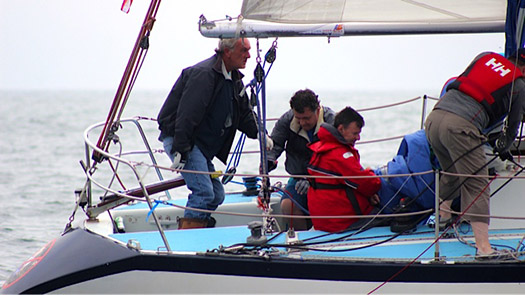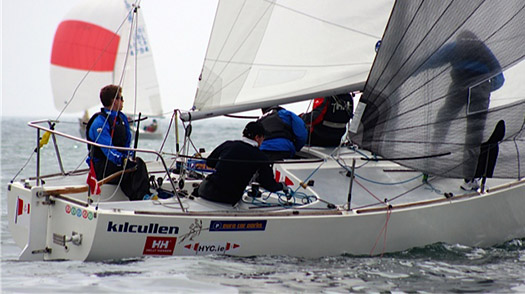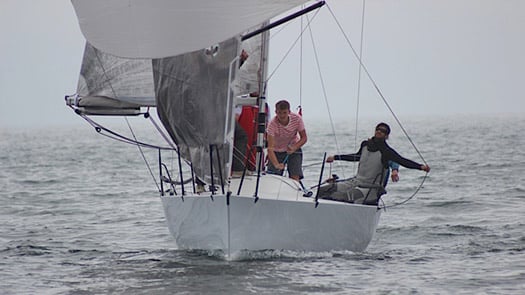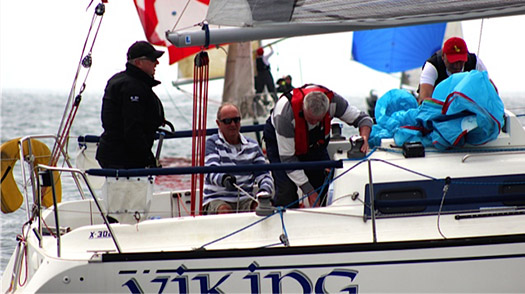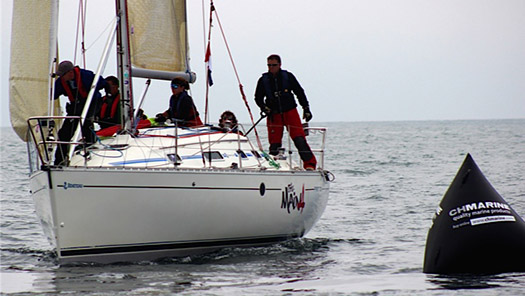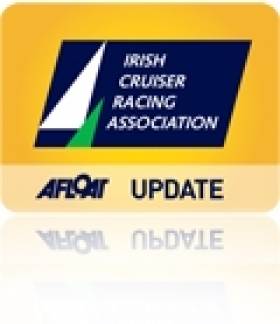Displaying items by tag: Fool's Gold
#dlregatta – With the Kinsale ICRA Nats/Sovereigns Trophy 2015 very successfully concluded last weekend, and a classic Dun Laoghaire to Dingle Race put stylishly in place before that, the feeling of another sailing summer busily in progress is all-pervasive. But while the image projected may well be one of stately progress by the cruiser-racer fleets along the Irish coast, taking in an offshore race here and a regatta there with much leisurely cruising in between, the reality is usually otherwise. For those boats doing significant segments of the programme, it's a case of fitting chosen events into the usual hectic early summer life of work and family commitments and exams and everything else, with the re-location of boats to the next venue being a hurried task undertaken by delivery crews.
Next week sees the mid-season peak of the sailing summer, with the four day Volvo Dun Laoghaire Regatta 2015 in Dublin Bay from Thursday July 9th to Sunday July 12th. In a way it is an amalgamation of all that has has already occurred in this year's season, together with new elements to make it a unique sailfest which celebrates the fact that the citizens of Ireland's capital city and their guests can be conveniently sailing and racing within a very short distance of the heart of town. W M Nixon sets the scene
In the dozen or so years since its inception, the biennial Volvo Dun Laoghaire Regatta has settled itself firmly into the sailing scene as an exceptionally varied event in terms of the boats and classes taking part. There are five regular cruiser-racer classes, plus an offshore division, fourteen one design keelboat classes, and nine dinghy classes. And although there are contenders from Ireland's north coast and from the Cork area and south coast too, together with one gallant entry from Galway, it is essentially an Irish Sea Sailfest, though with a remarkably strong Scottish presence.
However, it was on the coast of Wales at 8.0pm last night that this sailing celebration began, with an ISORA Race starting in Holyhead and heading for Dun Laoghaire to set this large and complex programme into action towards a culmination on Dublin Bay in eight days time with the conclusion of VDLR2015.
2015 marks the Bicentennial of the Royal Dee YC, which was founded in 1815 on the Cheshire shores of the River Dee estuary where northwest England marches with northeast Wales. Originally the Dee Yacht Club (and founded, it's said, a month or two before the Royal Yacht Squadron came into being in the south of England, making the RDYC the second-oldest Royal yacht club in England after the Royal Thames), the Cheshire club became the Royal Dee YC in 1847.
Although the great prosperity of Liverpool in the 19th century saw the club's fleet of substantial yachts gathered in the Dee and then increasingly in the Mersey, by the late 1900s it was looking to the Menai Straits area as the focus of its keelboat events. As well, the completion of Holyhead breakwater in 1873 added a new and important harbour to its list of possible big boat sailing locations, and there was an increase in the number of cross-channel "matches" which the Royal Dee and the Royal Mersey, in conjunction with the Dublin Bay clubs, had already been running for some years.

A Royal Alfred YC cross-channel match from Dublin Bay to Holyhead gets under way in 1888. Cross-channel links were strong in the latter half of the 19th Century, and with the new breakwater completed at Holyhead in 1873, a new venue was available both for the Irish clubs and those on the other side such as the Royal Dee and the Royal Mersey

The bicentenary logo of the Royal Dee YC. In 1815, this club on the Cheshire coast was founded shortly before the Royal Yacht Squadron in the souh of England, whose Bicentennial is being celebrated at the end of July.

Dun Laoghaire saw its first regatta staged in 1828, and participation by yachts from the northwest of England and North Wales was regularly recorded. This is the Royal St George YC regatta of 1871.
So when we say that the Royal Dee has always been a stalwart of offshore racing in the Irish Sea, we're not referring to a story spanning only the 20th and 21st Centuries. On the contrary, it goes well back into the 1800s. And now, with the revival of keelboat sailing in the Mersey with several of Liverpool's myriad docks being given over to recreational use, we have in a sense come full circle with enthusiastic Dublin Bay support of the Bicentennial celebrations reflecting sailing links which go back almost 200 years
The Lyver Trophy is the Royal Dee's premier offshore challenge, and this year it is special, as it's a fully-accredited RORC event counting for points in the annual championship, and a highlight of the ISORA Programme 2015. It's start scheduled for yesterday evening in Holyhead will see the fleet – mostly regular ISORA contenders – sail a course of at least a hundred miles before finishing in Dun Laoghaire. Then as VDLR 2015 gets under way, races in it, combined with the Lyver Trophy results, will count as part of a series towards finding an overall winner of the RDYC Bicentennial Trophy.
Only entrants in the Lyver Trophy race are eligible, and for that race itself – which can be followed on the Averycrest Yellowbrick Tracker - the favourite has to be the Shanahan family's J/109 Ruth, still buoyed up by her great victory in the Dun Laoghaire to Dingle Race three weeks ago.

Back in The Bay – the Shanahan family's J/109 Ruth will be back in her home waters of Dublin Bay after winning the Dun Laoghaire to Dingle Race and completing the Lyver Trophy Race from Holyhead which started last night. Photo: David O'Brien
At the other end of the size scale, the VDLR2015 Dublin Bay programme includes several dinghy classes, and the biggest fleet will be mustered by the International GP 14s, who have designated the racing in Dublin Bay as their Leinster Championship. In an interview with Sailing on Saturday in March, VDLR Chairman Tim Goodbody emphasised that, overall, the event should be seen as a regatta rather than a championship, and for most boats that's just what it will be. But the GP 14s with their great esprit de corps have always done things their own way, and with their compact boat size – albeit comprising a large fleet of dinghies – they reckon they can get in a proper championship while sharing in the fun of the event.
 The brothers John and Donal McGuinness of Moville Sailing Club in Donegal are expected to be among the pace-setters in the GP 14 class with their superb Alistair Duffin-built boat. Photo: W M Nixon
The brothers John and Donal McGuinness of Moville Sailing Club in Donegal are expected to be among the pace-setters in the GP 14 class with their superb Alistair Duffin-built boat. Photo: W M Nixon

The GP 14 Ulsters 2015 were recently won on Lough Erne by Shane MacCarthy & Damian Bracken of Greystones
As to who is favourite, the McGuinness brothers – Donal and John - from Moville in Donegal, with their top-of-the-line Duffin boat built in Northern Ireland, have to be in the reckoning after being top Irish at last year's Worlds on Strangford Lough, but there's fresh blood in the fleet with the newest class developing at Youghal, while this year's recent Ulster Championship on Lough Erne was won by the Greystones duo of Shane MacCarthy and Damian Bracken.
The dozen and more boats coming south from Scotland, most of them substantial cruiser-racers, are testimony to a growing trend in sailing on Europe's Atlantic seaboard. Given a choice of venues, your average yachtie on this long coastline will incline to head south if at all possible. Other things being equal, it's reckoned the further south you go the warmer it is likely to be. And from the upper reaches of the Firth of Clyde, there are times when Dublin Bay might seem like the distant and sunny Mediterranean.
Maybe so, but we'd caution that much depends on the moods and location of that all-powerful weather determinant, the northern Polar Jetstream. In July, so long as it's well clear of Ireland -whether to the north or the south - we will have glorious high summer, and that occurred for the previous VDLR back in 2013, where the photos speak for themselves.
So we hope for the best in looking forward to welcoming a fleet of around 415 boats to Dun Laoghaire between July 9th and 12th, with all four of our in-harbour yacht clubs extending the hand of hospitality in a regatta tradition that goes right back to 1828. But while heritage and ceremonial are all very well in their place, it's the prospect of good sport which energises the participants and their sailing, and with several major contests already logged in 2015, what can we expect on the leaderboards next week?
At the top of the tree, Class 0 has formidable competition, including former Scottish champion Jonathan Anderson racing his XP38i Roxstar against the Royal Cork's Conor Phelan with the Ker 37 Jump Juice, which was one of the best performers in last year's ICRA Nationals at the same venue, and this year again became a force to be reckoned with as the breeze sharpened in the four day Kinsale ICRA Nats 2015/Sovereigns Cup a week ago.
 Freshly squeezed – her storming finish to last weekend's final race of the ICRA Nats/Sovereigns Cup at Kinsale makes Conor Phelan's Ker 37 Jump Juice one of the top contenders in the VDLR2015. Photo: David O'Brien
Freshly squeezed – her storming finish to last weekend's final race of the ICRA Nats/Sovereigns Cup at Kinsale makes Conor Phelan's Ker 37 Jump Juice one of the top contenders in the VDLR2015. Photo: David O'Brien
With a win in the final race, Jump Juice came in second to seasoned campaigner George Sisk's class overall winning Farr 42 WOW (RIYC), the pair of them in turn displacing the early leader, lightweight flyer Mills 36 Crazy Horse (ICRA Commodore Nobby Reilly & Alan Chambers, HYC) down to third in the final day's racing, so Crazy Horse will be hoping for a return of lighter breezes when racing starts next Thursday on Dublin Bay.
In the previous Volvo Dun Laoghaire Regatta in 2013, the most successful boat in was Nigel Biggs' much-modified Humphreys Half Tonner Checkmate XV, but this year the Biggs team is racing as Checkmate Sailing with the newest boat in the fleet, the Mark Mills-designed American-built C & C 30 OD Checkmate XVI. She may be only 30ft LOA, but she's such a hot piece of work with so many go-fast bells and whistles that she has a rating of 1.140 to put her in Class 0.
The oldest boat in the cruiser-racer fleets will be found in Class 3, where the 44ft Huff of Arklow is making an historic return to Dublin Bay racing. Originally built in 1951 by Jack Tyrrell of Arklow to a design by dinghy genius Uffa Fox, Huff is so-called because her concept is reckoned three-quarters Uffa Fox and one quarter Douglas Heard. The latter was the founding President of the Irish Dinghy Racing Association in 1946, and he later went onto to become Commodore of the Royal St George YC and a noted cruising and offshore racing enthusiast with this unusual boat, which is like a very enlarged Fying Fifteen with a lid – in fact, with her 30ft-plus waterline, she was described as a Flying Thirty. In recent years she has undergone a total restoration with Cremyll Keelboats near Plymouth in Devon, and Dominic Bridgeman of the Cremyll group will be racing her with trainee crews in her old home waters of Dublin Bay.

The Flying Thirty Huff of Arklow racing off Dublin Bay while under Douglas Heard's ownership in the 1950s. Built by Tyrrell's of Arklow in 1951, the hugely innovative Huff has recently had a major restoration, and will be making her return to Dublin Bay to take part in VDLR2015.
Among the newer boats on the bay, the 2013 champion Checkmate XV is still very much in the picture, but now she's owned by Howth's Dave Cullen, and took second overall in class in the Kinsale series a week ago. In Dun Laoghaire next week, she's with other Half Tonners at the lower end of the Class 2 rating band on 0.944, almost 200 rating points below the new Biggs boat. Class 2 also includes the Division 3 winner at Kinsale, Richard Colwell & Ronan Cobbe's Corby 25 Fusion (HYC) which bested VDLR 205 Chairman's Sigma 33 White Mischief in a real duel after they went into the final day's racing equal on points, while another Kinsale success story in the Class 2 lineup is Paddy Kyne's X302 Maximus from Howth, overall winner of the Portcullis Trophy for top ECHO boat.

Dave Cullen's modified Half Tonner Checkmate XV will be looking to take the top slot on Dublin Bay after being runner-up in Kinsale. Photo: David O'Brien
In between the two Checkmates on ratings, we find most of the cruiser-racer fleet, with Class 1 shaping up some interesting competition between the likes of Paul O'Higgins Corby 33 Rockabill (RIYC), Kenneth Rumball skippering the Irish National Sailing School's Reflex 38 Lynx, and two very sharp First 35s, Prima Luce (Burke, Lemass & Flynn, NYC & RIYC) and another former Scottish Series champion, John Corson (Clyde Cr C) with Salamander XXI.
This year's Scottish Series Champion and the Afloat.ie "Sailor of the Month" for May, Rob McConnell of Dunmore East, will certainly be racing in the VDLR 2015, but whether or not it's with his all-conquering A35 Fool's Gold (second in class at Kinsale) or aboard another boat (a Flying Fifteen) remains to be seen. And the Top Sailor Count doesn't end there, as there'll be at least four Olympic sailors involved in four different classes, with Robin Hennessy racing in what has all the marks of a quality International Dragon fleet against the likes of former Edinburgh Cup winner Martin Byrne, Annalise Murphy racing in the Moths which will surely be a change from the Water Wag which she raced with her mother Cathy MacAleavy (also another ex-Olympian) last time round, and Mark Mansfield helming John Maybury's J/109 Joker 2. After Joker 2's class overall win in Kinsale, we can expect a battle royal in the J/109s with boats of the calibre of Ruth for the National title fight.

The Shipman 28s find that the sport and socializing which the VDLR guarantees will provide some of their best racing of the year. Photo: VDLR
The J/109s are the queens of an impressive array of One Design keelboats which includes Sigma 33s (where VDLR 2015 Chairman Tim Goodbody's White Mischief is racing under the command of Paul McCarthy), Beneteau First 31.7s, Shipman 28s having one of their best gatherings of the year, Ruffian 23s with a good turnout, the attractive First 21s which are steadily gaining traction as a Dublin Bay class, and best OD keelboat turnout of all is by the Flying Fifteens, nearly all of them under the NYC flag.

Olympians all – in VDLR2013, Olympic sailors Cathy MacAleavey (1988) and her daughter Annalise Murphy (2012) raced the family Water Wag Mollie. But while Cathy will be sailing Mollie again this year, Annalise will be on her own racing a foiling International Moth.

Newest of the oldest – Adam Winkelmann and Doug Smith's new French built Water Wag No.46, Madameoiselle, has been launched in time for the regatta. Photo: Owen McNally

The Howth 17s of 1898 vintage will be the oldest class racing. Photo: David Branigan
Veteran classes include the IDRA 14s from 1946, the Glens from 1945, the Howth 17s of 1898 which pre-date the 1902 Water Wags, and the 1932 Mermaids, the latter being in the interesting position of no longer having an official division in Dun Laoghaire, yet it's a Dun Laoghaire skipper, Jonathan O'Rourke of the National, who continues to dominate the class both at home and away.
With large fleet numbers afloat guaranteed, the shoreside programme is appropriately busy, with the official side of each day's racing concluded by the evening's daily prize-giving at one of the four waterfront clubs. But with so many sailors involved, there'll be action in all the clubs – and at other establishments in Dun Laoghaire - throughout the week. The scene is set, let the party begin at a venue which has been staging regattas since 1828.
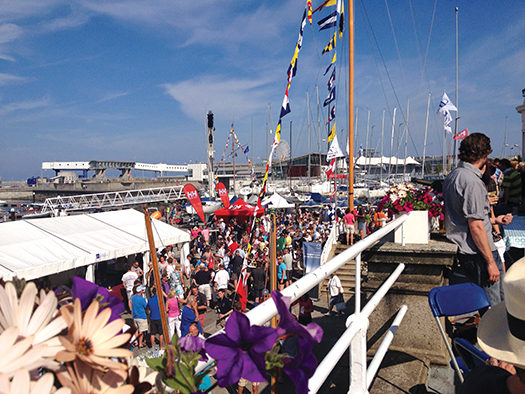
When the summer comes, the après sailing at the VDLR is world class. Photo: VDLR
Further reading:
Download the full entry list for Dun Laoghaire Regatta 2015 class by class below
Download the Sailing Instrcutions for Dun Laoghaire Regatta 2015 HERE
- Dun Laoghaire Regatta
- Volvo Dun Laoghaire Regatta
- Royal St George Yacht Club
- Royal Irish Yacht Club
- National Yacht Club
- ISORA
- Water Wags
- Royal Alfred Yacht Club
- yellowbrick
- GP 14
- Nigel Biggs
- George Sisk
- Annalise Murphy
- Half Tonners
- Tim Goodbody
- Mermaid
- Fool's Gold
- Dragon
- Irish National Sailing School
- Kenneth Rumball
- Dublin Bay
#sovscup – No surprises that form boat Jelly Baby leads division one of the 2015 ICRA Nationals in Kinsale Yacht Club tonight writes Claire Bateman. No surprise either that another Irish UK champion this season is also in the frame after two light races on the south coast.
The annual (ICRA) championship that combines the club's Sovereigns' Cup event runs until Saturday. The event featured in today's Afloat enews. For more click here.
Forecasted moderate to fresh south–westerly winds gusting up to 25 mph that look set to provide perfect racing conditions for the 122–boat fleet failed to materialise this afternoon as did the summer sunshine.
Ian Nagle's Royal Cork leader – that has already chalked up two UK victories this season – is a single point ahead of J109 sistership Joker II (John Maybury) in the biggest fleet of the championship. Third, six points off the lead, is May's Scottish series winner Fool's Gold skippered by Rob McConnell of Waterford Harbour, Afloat's sailor of the month for May.
But despite the Munster lead in division in one, it is Howth Yacht Club that has set a strong early pace in the four-day series off the Old Head of Kinsale. The north Dublin club holds leading places in four of the eight racing divisions including the top four boats in Division 2.
Kinsale was like a deserted village when everybody had taken to the water. The day was dull and had what started out as a light breeze that filled in later in the day.
Former RCYC Admiral Peter Deasy reported from Class Three that it was very competitive and a very enjoyable day's racing.
Fleets were divided into red and green to alternate each day between windward/leeward and round the cans courses.
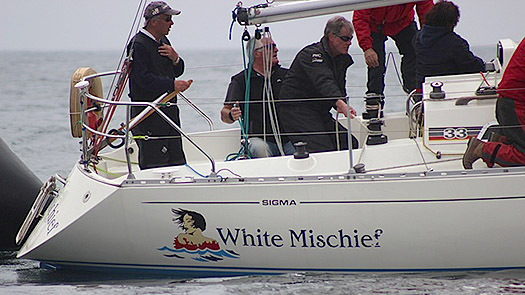
Champion Sigma 33 White Mischief skippered by Timothy Goodbody of the Royal Irish Yacht Club is fourth in class three
Class Three were to sail today on the round the cans course but due to the fickle breeze in the morning Race Officer Jack Roy set a windward/leeward course and shortened it to two rounds instead of three. As the wind filled in during the day a round the cans course was set and while the Desmond/Deasy Ivers Bad Company (RCYC) led all the way from the weather mark, she was caught at the finish by Richard Colwell's Corby 25 who had a two and a one in IRC with Bad Company on three and two in second and another Corby 25 , Paul Tingle's Alpaca (RCYC) also enjoying the lighter conditions lying third.
Meanwhile, in Alan Crosbie's red fleet sailing the windward/leeward course were Classes Zero, One and Two, and in the lighter airs of the morning ICRA Commodore, Norbert Reilly, sailing the Mills 36 Crazy Horse Zero took the first gun followed by regular visitor to Ireland Andy Williams of Yealm Yacht Club in his Ker 40 Keronimo, in second but these positions were reversed in Race Two so an interesting battle is already developing in this fleet. Currently lying third is the Jonathan Anderson Roxstar an XP381 followed by local RCYC boat Denise and Conor Phelan's Jump Juice.
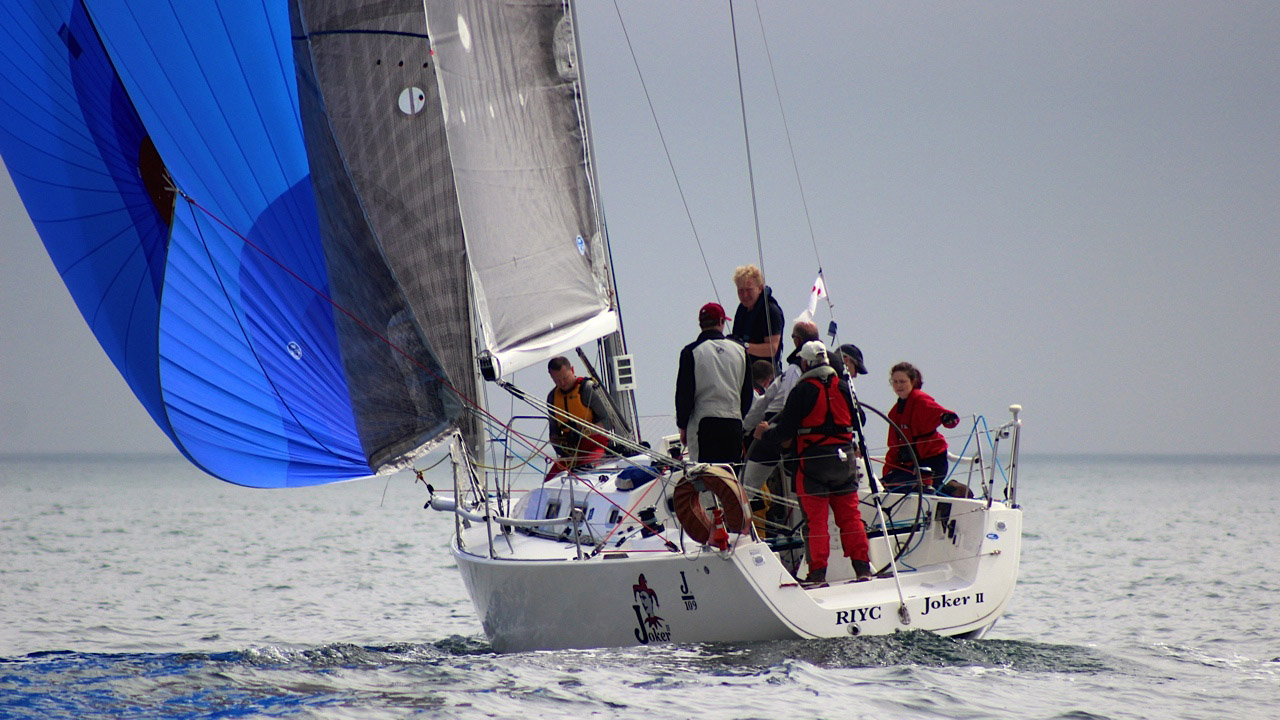
Dublin Bay's Joker II is second overall in IRC one
As previously mentioned, in Division One IRC, one of the hardest fought divisions the current two first places are occupied by RCYC Ian Nagle's J109 Jelly Baby, currently riding high on a succession of major wins, followed John Maybury's Joker 2 another J109 and a previous winner of this class Rob McConnell's Archambult 35 Fool's Gold in third place. Following in fourth place is Richad Fides Corby 33, with Paul O'Higgins Rocakbill V in fifth and Pat Kelly's J109 Storm in sixth place. A truly formidable line up and a good week of battle to look forward to.

The Quarter Tonner Cartoon (Ken Lawless, Joe Brady, Sybil McCormack) second in class four
As reported today in Afloat.ie, the battle for the half tonners is in already in full swing. With the first four positions dominated by Howth Yacht Club led by David Cullen's Checkmate XV with two wins, with Harmony having to be content with two seconds. Lying third is the well travelled Equinox the X332 of Ross McDonald on equal points with another half tonner Michael and Richard Evans The Big Picture.
Tomorrow's winds are expected to be stronger so a great day's racing lies in store
Results ICRA Nationals & Sovereign's Cup 2015
Day 1, after 2 races sailed (24th June 2015)
Division 0 IRC
1 Keronimo, Andy Williams (Yealm Yacht Club)
2 Crazy Horse, Norbert Reilly/Alan Chambers (Howth Yacht Club)
3 Roxstar, Jonathan Anderson, (Clyde Cruising Club)
Division 0 ECHO
1 Roxstar, Jonathan Anderson, (CCC)
2 Crazy Horse, Norbert Reilly/Alan Chambers (HYC)
3 Forty Licks, Jay Colville, East Down YC
Division 1 IRC
1 Jelly Baby, Ian Nagle, (Royal Cork Yacht Club)
2 Joker 2, John Maybury, (Royal Irish Yacht Club
3 Fool's Gold, Robert McConnell (Wicklow Harbour SC)
Division 1 ECHO
1 Adrenalin, Joe McDonald (National Yacht Club)
2 Raptor, Denis Hewitt & others (RIYC)
3 Joie de Vie, Glenn Chaiul, Silvie Blazkova (Galway Bay SC)
Division 2 IRC
1 Checkmate XV, Davie Cullen, HYC
2 Harmony, Jonny Swan/James Freyne, HYC
3 Equinox, Ross McDonald, HYC
Division 2 ECHO
1 Harmony, Jonny Swan/James Freyne, HYC
2 Jostler, Patrick Beckett, (KYC)
3 Checkmate XV, Davie Cullen, HYC
Division 3 IRC
1 Fusion, Richard Cowell, (HYC)
2 Bad Company, Desmond, Ivers, Deasy (RCYC)
3 Alpaca, Paul & Deirdre Tingle (RCYC)
Division 3 ECHO
1 Reavra, Stephen Lysaght (KYC)
2 Maximus, Paddy Kyne (HYC)
3 White Mischief, Timothy Goodbody (RIYC)
Division 4 IRC
1 Blackfun, Tony Hayward (Cowes)
2 Cartoon, Ken Lawless, Joe Brady, Sybil McCormack (RIYC)
3 Anchor Challenge, Paul Gibbons, (RCYC)
Division 4 ECHO
1 White Magic, Donal Harding, Waterford Harbour Sailing Club
2 No-Gnomes, Leonard Donnery, (RCYC)
3 Seven Whistler, Rene Wubben (WHSC)
J109
1 Jelly Baby, Ian Nagle (RCYC)
2 Joker 2, John Maybury (RIYC)
3 Storm, Pat Kelly (Rush SC/HYC)
Quarter Tonner
1 Cartoon, Ken Lawless, Joe Brady, Sybil McCormack (RIYC)
2 Blackfun, Tony Hayward (Cowes)
3 Anchor Challenge, Paul Gibbons (RCYC)
White Sail Division 1 IRC
1 White Lotus, Paul Tully, (Dun Laoghaire Motor YC)
2 Bite the Bullet, Colm Bermingham, (HYC)
3 Val Kriss,Nigel Dann (KYC)
White Sail Divison 1 ECHO
1 White Lotus, Paul Tully, (Dun Laoghaire Motor YC)
2 Baccarat, Anthony/Brian McCarthy (KYC)
3 Sonas, David Ross (KYC)
White Sail Division 2 IRC
1 Demelza, Windsor Laudan, (HYC)
2 Loch Greine, Tom O'Mahony (RCYC)
3 Saoirse, Richard Hanley (KYC)
White Sail Division 2 ECHO
1 Loch Greine, Tom O'Mahony (RCYC)
2 Demelza, Windsor Laudan, (HYC)
3 Guinness Kann, Caroline Forde (KYC)_
Full results here
